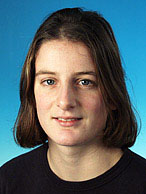Ir. Mrs T. A. (Tineke) Troost

Self organisation of community metabolism
Introduction
All around us, areas of land and volumes of water contain assemblages
of different species, in different proportions and doing different
things. An important property of such communities is that the species
interact. Together they form very complex food webs, with
plants, herbivores, detritivores and carnivores.
Naturally, the precise type of communities that arise depend on their
environment they live in, but equally important is the feedback from
the communities on the environment. Together, a community and its
environment are called an ecosystem.
The phenomenons of `ecosystem' and `food web' give rise
to many questions:
- Is there an advantage of a food web over a single species
community? And if so: In what way is it advantageous?
- Why and how did ecosystems/food webs come into being?
- Was it inevitable that species have organized into food webs?
- Why is a certain role in the food web often performed by similar
looking species?
- Why are detritivores (for example bacteria) often very small?
- ....
Aim of study
In this project the 'evolution' of ecosystems is studied. Objective is
to get more insight in the organization of species into food
webs. Also we study the coupling between function and structure in
biological communities.

Evolution: from a single-species community to a complete foodweb
Methods
In this project we try to make a model that is capable of organizing
itself in simple food webs.
- We start with a model from a single-species community of
mixotrophs. Mixotrophs can use energy of both organic and
inorganic sources, and are thus completely
selfsufficient. Evolution is added to the model in the form
of small and random mutations, which will give the system freedom to
go in several ways and will thus make self-organization
possible.
- Then we will study the specialisation of the mixotrophs
into separate heterotrophs and autotrophs. Heterotrophs and
autotrophs are mutually dependend on each other and thus will have
to form a very simple food web in order to survive.
- From there on we will extend the model with detritivores
and carnivores, to achieve more complex and realistic food
webs. These food webs, in combination with the body size scaling
relationships already present in the models, will enable us to
study the coupling between function and structure in
biological communities.
We will try to model this whole process of self organization by
combining two existing theories (Dynamic Energy Budget and Adaptive
Dynamics). AD is used to quantify adaptation and speciation in
organisms, DEB specifies general rules for uptake and use of
substrates in organims. A short description of both theories is given
below.
Adaptive Dynamics: The theory on Adaptive Dynamics (AD) is
about quantitative changes at an evolutionary time scale in
characteristics of species, as described by parameter values. These
characteristics include rules for the (sloppy) heredity of parameter
values in parent-offspring transitions. The theory can predict under
what circumstances the scatter distribution of individual-specific
parameters values breaks up, a process that corresponds with
speciation.
Dynamic Energy Budget:
The Dynamic Energy Budget Theory (DEB) is a general framework for
modeling organisms, which links different levels of biological
organisation (cells, organisms and populations). The theory presents
simple mechanistic rules that describe the uptake and use of energy
and nutrients (substrates, food, light) and the consequences for
physiological organisation throughout an organism's life cycle.
This is the symposium that concludes my project:


